Academic career
Doran read History at St Anne's College, Oxford before obtaining a PGCE and beginning a teaching career at St Paul's Girls' School in Hammersmith. In the 1970s Doran completed a PhD at University College London, with her thesis being a political biography of Thomas Radclyffe, 3rd Earl of Sussex. Beginning in 1986 she taught early modern British and European history at St Mary's University College in Strawberry Hill, serving as head of the History Department for several years. [2] When she left the college in 2001, she was Reader in History.
Doran returned to the University of Oxford as a lecturer at Christ Church in 2002. In 2004 she was elected a Fellow of St Benet's Hall, Oxford, and in 2009 was elected a Senior Research Fellow at Jesus College, Oxford. [3] In 2016 the university awarded her the title of Professor of Early Modern British History. [4] In 2018 Doran served as acting Master of St Benet's Hall while Werner Jeanrond was on sabbatical. [5]
Doran is a Fellow of the Royal Historical Society and an Honorary Fellow of the Historical Association. [6]
Broadcasting
Doran has appeared in many historical documentaries and podcasts as an expert commentator.
Doran has participated in numerous Tudor history documentaries produced by the BBC. In 2016 she appeared in an episode of A Timewatch Guide focused on Elizabeth I, presented by Vanessa Collingridge. [7] In 2020 she appeared in Royal History's Biggest Fibs, presented by Lucy Worsley, discussing the Spanish Armada and the relationship between Elizabeth I and Philip II of Spain. [8] She also appeared in 2021's The Boleyns: A Scandalous Family, discussing Henry VIII's marriage to Anne Boleyn. [9]
Other documentary appearances include the 2010 National Geographic film Secrets of the Virgin Queen [10] and an episode of the 2015 Yesterday series Medieval Murder Mysteries focused on the death of Amy Robsart. [11] In 2018 she acted as a historical consultant for an episode of Britain's Most Historic Towns , presented by Alice Roberts, exploring the city of Norwich in the Tudor period. [12]
In April 2024 Doran was the guest for the first ever live recording of Suzannah Lipscomb's podcast Not Just the Tudors at the Gloucester History Festival's spring weekend, where she discussed the succession of James I to the English throne. [13]

Elizabeth I was Queen of England and Ireland from 17 November 1558 until her death in 1603. She was the last monarch of the House of Tudor.

The House of Tudor was an English and Welsh dynasty that held the throne of England from 1485 to 1603. They descended from the Tudors of Penmynydd, a Welsh noble family, and Catherine of Valois. The Tudor monarchs ruled the Kingdom of England and the Lordship of Ireland for 118 years with five monarchs: Henry VII, Henry VIII, Edward VI, Mary I and Elizabeth I. The Tudors succeeded the House of Plantagenet as rulers of the Kingdom of England, and were succeeded by the Scottish House of Stuart. The first Tudor monarch, Henry VII, descended through his mother from the House of Beaufort, a legitimised branch of the English royal House of Lancaster, a cadet house of the Plantagenets. The Tudor family rose to power and started the Tudor period in the wake of the Wars of the Roses (1455–1487), which left the main House of Lancaster extinct in the male line.
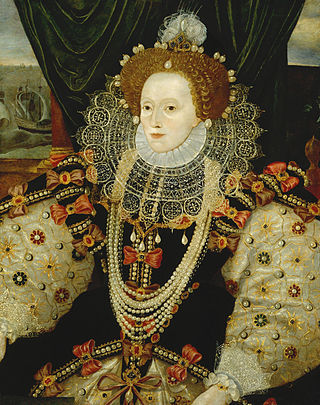
The Elizabethan era is the epoch in the Tudor period of the history of England during the reign of Queen Elizabeth I (1558–1603). Historians often depict it as the golden age in English history. The symbol of Britannia was first used in 1572, and often thereafter, to mark the Elizabethan age as a renaissance that inspired national pride through classical ideals, international expansion, and naval triumph over Spain.
Early modern Britain is the history of the island of Great Britain roughly corresponding to the 16th, 17th and 18th centuries. Major historical events in early modern British history include numerous wars, especially with France, along with the English Renaissance, the English Reformation and Scottish Reformation, the English Civil War, the Restoration of Charles II, the Glorious Revolution, the Treaty of Union, the Scottish Enlightenment and the formation and the collapse of the First British Empire.

In England and Wales, the Tudor period occurred between 1485 and 1603, including the Elizabethan era during the reign of Elizabeth I (1558–1603). The Tudor period coincides with the dynasty of the House of Tudor in England, which began with the reign of Henry VII. Under the Tudor dynasty, art, architecture trade, exploration and commerce flourished. Historian John Guy (1988) argued that "England was economically healthier, more expansive, and more optimistic under the Tudors" than at any time since the Roman occupation.
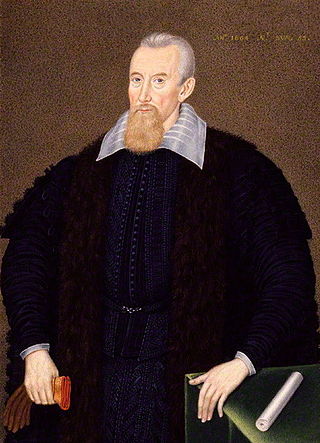
Edward Bruce, 1st Lord Kinloss PC was a Scottish lawyer and judge.
The 1583 Throckmorton Plot was one of a series of attempts by English Roman Catholics to depose Elizabeth I of England and replace her with Mary, Queen of Scots, then held under house arrest in England. The alleged objective was to facilitate a Spanish invasion of England, assassinate Elizabeth, and put Mary on the English throne.
Events from the 1530s in England.
Anne, Lady Shelton née Boleyn was a sister of Thomas Boleyn, 1st Earl of Wiltshire, and one of the aunts of his daughter, Queen Anne Boleyn, the second wife of King Henry VIII.

The portraiture of Queen Elizabeth I (1533–1603) spans the evolution of English royal portraits in the early modern period (1400/1500-1800), from the earliest representations of simple likenesses to the later complex imagery used to convey the power and aspirations of the state, as well as of the monarch at its head.
Sir John Ernest Neale was an English historian who specialised in Elizabethan and Parliamentary history. From 1927 to 1956, he was the Astor Professor of English History at University College London.
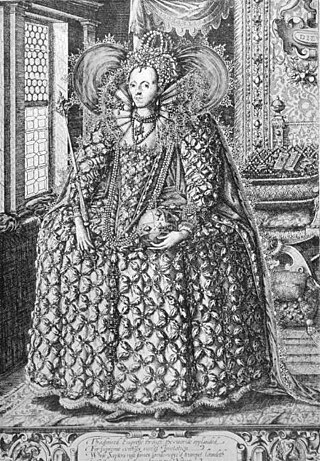
William Rogers was an English engraver. A Citizen of the City of London – one of his surviving engravings is signed Anglus et Civis Lond(oniensis). – he is the first English craftsman known to have practised engraving and the greatest portrait engraver of the Tudor period. The English were extremely late in coming to printmaking, though several artists from the thriving Flemish industry had worked in England already; the engraved print had been invented over 150 years before Rogers began to produce them. Rogers was also a goldsmith, and presumably acquired his technique in that context. His portrait style reflects Flemish models, while his backgrounds are often "overloaded with ornament" that is "redolent of the goldsmith's shop".

Essex's Rebellion was an unsuccessful rebellion led by Robert Devereux, 2nd Earl of Essex, in 1601 against Queen Elizabeth I of England and the court faction led by Sir Robert Cecil to gain further influence at court.

Brett Usher was an English actor, writer and ecclesiastical historian. Although he appeared frequently on stage and television, it was as a radio actor that he came to be best known. His many radio roles ranged widely, from farce to Shakespeare and new works. In addition to acting he also wrote for radio.
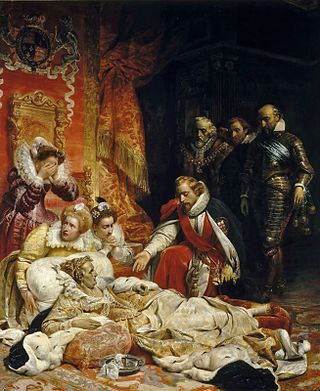
The succession to the childless Elizabeth I was an open question from her accession in 1558 to her death in 1603, when the crown passed to James VI of Scotland. While the accession of James went smoothly, the succession had been the subject of much debate for decades. It also, in some scholarly views, was a major political factor of the entire reign, if not so voiced. Separate aspects have acquired their own nomenclature: the "Norfolk conspiracy", Patrick Collinson's "Elizabethan exclusion crisis", and the "Secret Correspondence".
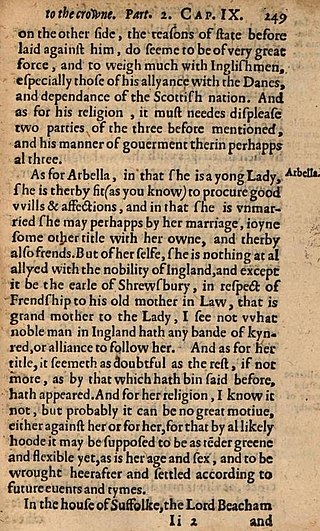
A Conference about the Next Succession was a pseudonymous book published by "Doleman", and dealing with the succession to Elizabeth I of England. The cover date is 1594, but the real publication date is taken to be around September 1595, in Amsterdam. The author has traditionally been identified with Robert Persons, an English Jesuit exile. It has also been suggested that Doleman is a collective pseudonym.
Susan Elizabeth Brigden, FRHistS, FBA is a historian and academic specialising in the English Renaissance and Reformation. She was Reader in Early Modern History at the University of Oxford and a Fellow of Lincoln College, before retiring at the end of 2016.
Richard Bruce Wernham, was an English historian of Elizabethan England. After his death The Times called him "the leading historian of English foreign policy in the 16th century".
A silkwoman was a woman in medieval, Tudor, and Stuart England who traded in silks and other fine fabrics. London silkwomen held some trading rights independently from their husbands and were exempted from some of the usual customs and laws of coverture. The trade and craft of the silkwoman was encouraged by a statute of Henry VI of England as a countermeasure to imports of silk thread, and a suitable occupation for "young gentlewomen and other apprentices".









